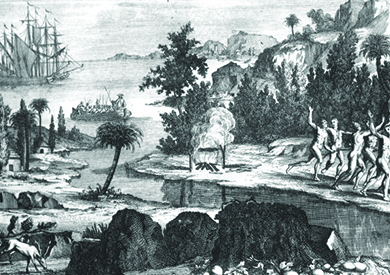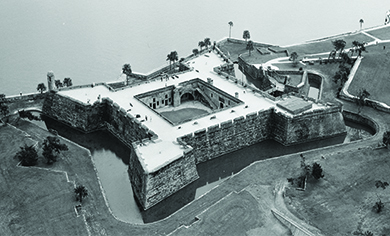| << Chapter < Page | Chapter >> Page > |
In 1565, the victorious Menéndez founded St. Augustine, now the oldest European settlement in the Americas. In the process, the Spanish displaced the local Timucua Indians from their ancient town of Seloy, which had stood for thousands of years ( [link] ). The Timucua suffered greatly from diseases introduced by the Spanish, shrinking from a population of around 200,000 pre-contact to fifty thousand in 1590. By 1700, only one thousand Timucua remained. As in other areas of Spanish conquest, Catholic priests worked to bring about a spiritual conquest by forcing the surviving Timucua, demoralized and reeling from catastrophic losses of family and community, to convert to Catholicism.

Spanish Florida made an inviting target for Spain’s imperial rivals, especially the English, who wanted to gain access to the Caribbean. In 1586, Spanish settlers in St. Augustine discovered their vulnerability to attack when the English pirate Sir Francis Drake destroyed the town with a fleet of twenty ships and one hundred men. Over the next several decades, the Spanish built more wooden forts, all of which were burnt by raiding European rivals. Between 1672 and 1695, the Spanish constructed a stone fort, Castillo de San Marcos ( [link] ), to better defend St. Augustine against challengers.

Browse the National Park Service’s multimedia resources on Castillo de San Marcos to see how the fort and gates have looked throughout history.
Further west, the Spanish in Mexico, intent on expanding their empire, looked north to the land of the Pueblo Indians. Under orders from King Philip II, Juan de Oñate explored the American southwest for Spain in the late 1590s. The Spanish hoped that what we know as New Mexico would yield gold and silver, but the land produced little of value to them. In 1610, Spanish settlers established themselves at Santa Fe—originally named La Villa Real de la Santa Fe de San Francisco de Asís, or “Royal City of the Holy Faith of St. Francis of Assisi”—where many Pueblo villages were located. Santa Fe became the capital of the Kingdom of New Mexico, an outpost of the larger Spanish Viceroyalty of New Spain, which had its headquarters in Mexico City.
As they had in other Spanish colonies, Franciscan missionaries labored to bring about a spiritual conquest by converting the Pueblo to Catholicism. At first, the Pueblo adopted the parts of Catholicism that dovetailed with their own long-standing view of the world. However, Spanish priests insisted that natives discard their old ways entirely and angered the Pueblo by focusing on the young, drawing them away from their parents. This deep insult, combined with an extended period of drought and increased attacks by local Apache and Navajo in the 1670s—troubles that the Pueblo came to believe were linked to the Spanish presence—moved the Pueblo to push the Spanish and their religion from the area. Pueblo leader Popé demanded a return to native ways so the hardships his people faced would end. To him and to thousands of others, it seemed obvious that “when Jesus came, the Corn Mothers went away.” The expulsion of the Spanish would bring a return to prosperity and a pure, native way of life.
In 1680, the Pueblo launched a coordinated rebellion against the Spanish. The Pueblo Revolt killed over four hundred Spaniards and drove the rest of the settlers, perhaps as many as two thousand, south toward Mexico. However, as droughts and attacks by rival tribes continued, the Spanish sensed an opportunity to regain their foothold. In 1692, they returned and reasserted their control of the area. Some of the Spanish explained the Pueblo success in 1680 as the work of the Devil. Satan, they believed, had stirred up the Pueblo to take arms against God’s chosen people—the Spanish—but the Spanish, and their God, had prevailed in the end.
In their outposts at St. Augustine and Santa Fe, the Spanish never found the fabled mountains of gold they sought. They did find many native people to convert to Catholicism, but their zeal nearly cost them the colony of Santa Fe, which they lost for twelve years after the Pueblo Revolt. In truth, the grand dreams of wealth, conversion, and a social order based on Spanish control never came to pass as Spain envisioned them.

Notification Switch
Would you like to follow the 'U.s. history' conversation and receive update notifications?